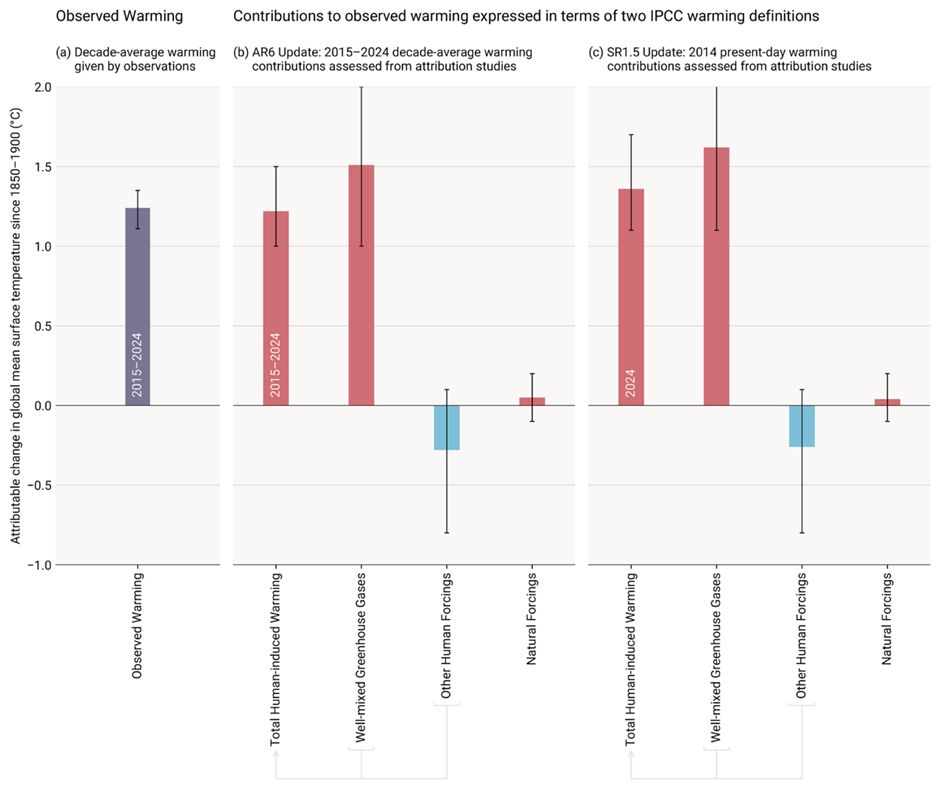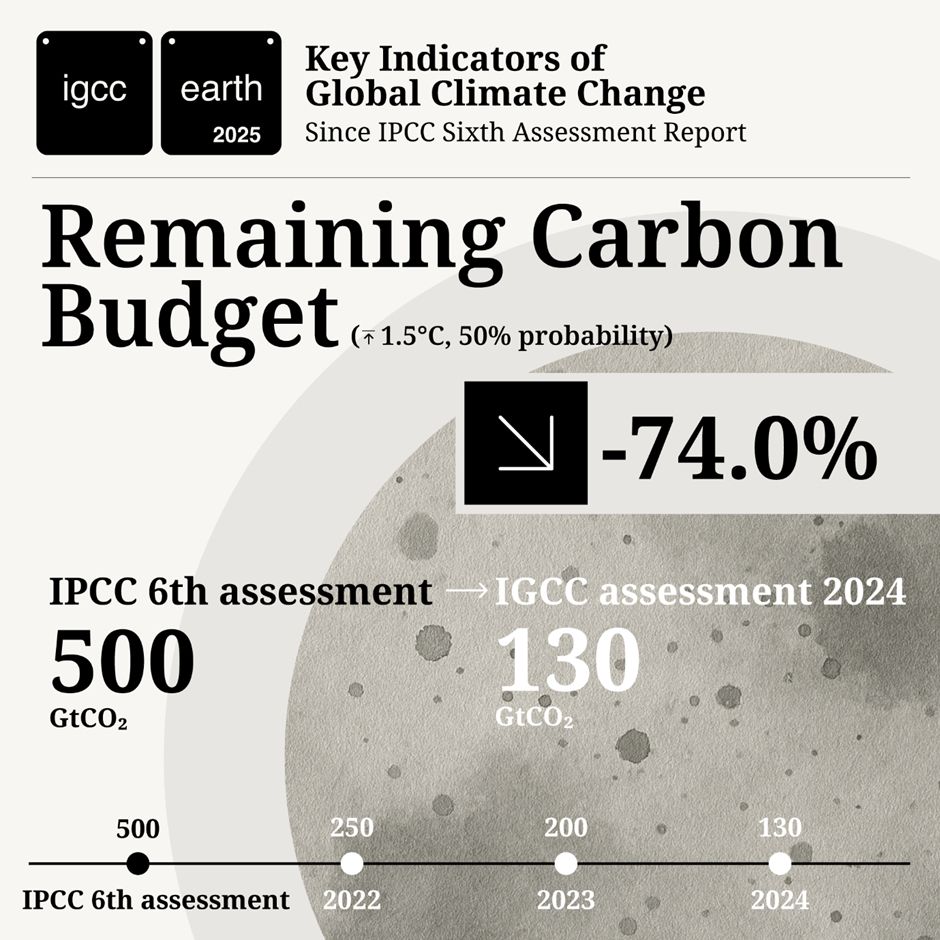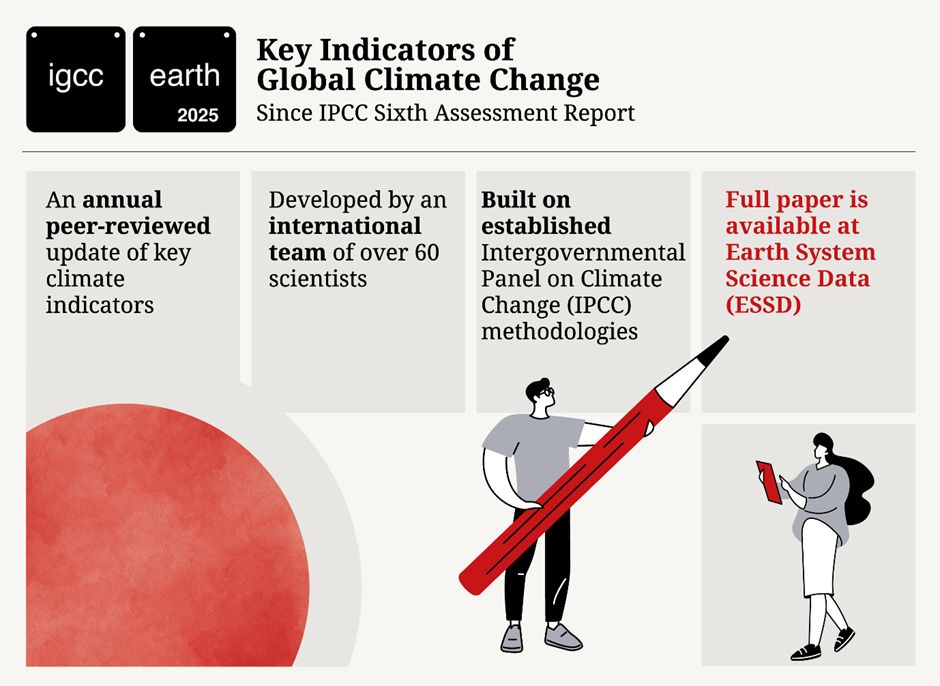
Joeri Rogelj
@joerirogelj.bsky.social
prof. climate science & policy | father | Imperial College London | 1.5C/net zero/carbon budget/pathways/justice | IPCC & UNEP lead author | ESABCC member
🧾The Paris Agreement's 1.5°C goal
The 1.5°C goal within the Paris Agreement's temperature goal refers to pursuing efforts to limit warming to 1.5°C.
This pursuit can continue whether we are below, at, or above 1.5°C of global warming. 3/
The 1.5°C goal within the Paris Agreement's temperature goal refers to pursuing efforts to limit warming to 1.5°C.
This pursuit can continue whether we are below, at, or above 1.5°C of global warming. 3/

June 23, 2025 at 1:51 PM
🧾The Paris Agreement's 1.5°C goal
The 1.5°C goal within the Paris Agreement's temperature goal refers to pursuing efforts to limit warming to 1.5°C.
This pursuit can continue whether we are below, at, or above 1.5°C of global warming. 3/
The 1.5°C goal within the Paris Agreement's temperature goal refers to pursuing efforts to limit warming to 1.5°C.
This pursuit can continue whether we are below, at, or above 1.5°C of global warming. 3/
IV) The last update takes into account the latest estimate of global warming. This estimate increased slightly due to the high observed temperatures in the last few years and resulted in a further reduction of the budget by around 40 GtCO2 relative to values reported in last year’s assessment. /6

June 20, 2025 at 1:59 PM
IV) The last update takes into account the latest estimate of global warming. This estimate increased slightly due to the high observed temperatures in the last few years and resulted in a further reduction of the budget by around 40 GtCO2 relative to values reported in last year’s assessment. /6
I) Since then, five years have passed during which about 200 GtCO2 were emitted. These continued high global CO2 emissions, mainly caused by fossil fuel use, are the main reason why the 1.5C remaining carbon budget has declined so much. /3

June 20, 2025 at 1:59 PM
I) Since then, five years have passed during which about 200 GtCO2 were emitted. These continued high global CO2 emissions, mainly caused by fossil fuel use, are the main reason why the 1.5C remaining carbon budget has declined so much. /3
In its 2021 Sixth Assessment Report, the @IPCC_CH reported a remaining carbon budget for limiting warming to 1.5C with at least 50% probability of 500 billion tons of CO2, starting from the beginning of 2020. /2
www.ipcc.ch/report/ar6/w...
www.ipcc.ch/report/ar6/w...

June 20, 2025 at 1:59 PM
In its 2021 Sixth Assessment Report, the @IPCC_CH reported a remaining carbon budget for limiting warming to 1.5C with at least 50% probability of 500 billion tons of CO2, starting from the beginning of 2020. /2
www.ipcc.ch/report/ar6/w...
www.ipcc.ch/report/ar6/w...
Headlines on international media report on 3 (or 2) years left before we exhaust the 1.5C carbon budget.
How did this year’s IGCC estimate of the remaining carbon budget end up with a 74% reduction compared to the latest @IPCC_CH report? A short deeper dive. /1
How did this year’s IGCC estimate of the remaining carbon budget end up with a 74% reduction compared to the latest @IPCC_CH report? A short deeper dive. /1

June 20, 2025 at 1:59 PM
Headlines on international media report on 3 (or 2) years left before we exhaust the 1.5C carbon budget.
How did this year’s IGCC estimate of the remaining carbon budget end up with a 74% reduction compared to the latest @IPCC_CH report? A short deeper dive. /1
How did this year’s IGCC estimate of the remaining carbon budget end up with a 74% reduction compared to the latest @IPCC_CH report? A short deeper dive. /1
IGCC is not setting a forecast though just a time when the remaining 1.5C budget will be spent. For projections of where we're heading go with @unep.org emissions gap report estimate. www.unep.org/resources/em...
Take top row for what countries are doing and bottom row for what they have promised.
Take top row for what countries are doing and bottom row for what they have promised.

June 19, 2025 at 6:08 PM
IGCC is not setting a forecast though just a time when the remaining 1.5C budget will be spent. For projections of where we're heading go with @unep.org emissions gap report estimate. www.unep.org/resources/em...
Take top row for what countries are doing and bottom row for what they have promised.
Take top row for what countries are doing and bottom row for what they have promised.
And of course there was a typo in the visual I posted earlier.
Three thumbs up and green heart for whoever can spot the difference between the former and current version.
🔎👁️🤯
Three thumbs up and green heart for whoever can spot the difference between the former and current version.
🔎👁️🤯

June 19, 2025 at 4:45 PM
And of course there was a typo in the visual I posted earlier.
Three thumbs up and green heart for whoever can spot the difference between the former and current version.
🔎👁️🤯
Three thumbs up and green heart for whoever can spot the difference between the former and current version.
🔎👁️🤯
The remaining carbon budget for 1.5C with 50% chance has been reduced from 500 billion tons of CO2 starting from 2020 in the IPCC report, to 130 billion tons starting from 2025. (a more detailed thread on this later) /9

June 19, 2025 at 8:23 AM
The remaining carbon budget for 1.5C with 50% chance has been reduced from 500 billion tons of CO2 starting from 2020 in the IPCC report, to 130 billion tons starting from 2025. (a more detailed thread on this later) /9
New in this year’s update is a closer look at sea level rise.
Not only has global average sea-level rise increased further, also the rate at which it progresses has increased and stands now at about 3.9 mm per year. /7
Not only has global average sea-level rise increased further, also the rate at which it progresses has increased and stands now at about 3.9 mm per year. /7

June 19, 2025 at 8:23 AM
New in this year’s update is a closer look at sea level rise.
Not only has global average sea-level rise increased further, also the rate at which it progresses has increased and stands now at about 3.9 mm per year. /7
Not only has global average sea-level rise increased further, also the rate at which it progresses has increased and stands now at about 3.9 mm per year. /7
On top of the human-caused warming, interannual natural variations mean that individual years can be warmer or cooler than the long-term trend.
However, virtually all of the warming observed until the past decade is caused by human activities. /6
However, virtually all of the warming observed until the past decade is caused by human activities. /6

June 19, 2025 at 8:23 AM
On top of the human-caused warming, interannual natural variations mean that individual years can be warmer or cooler than the long-term trend.
However, virtually all of the warming observed until the past decade is caused by human activities. /6
However, virtually all of the warming observed until the past decade is caused by human activities. /6
This causes global warming caused by human activity to increase. Human-induced global warming reached a record 1.22°C over the past decade and 1.36°C in 2024.
Uncertainty ranges around the 2024 value of 1.1-1.7°C already encompass the Paris 1.5°C limit. /5
Uncertainty ranges around the 2024 value of 1.1-1.7°C already encompass the Paris 1.5°C limit. /5

June 19, 2025 at 8:23 AM
This causes global warming caused by human activity to increase. Human-induced global warming reached a record 1.22°C over the past decade and 1.36°C in 2024.
Uncertainty ranges around the 2024 value of 1.1-1.7°C already encompass the Paris 1.5°C limit. /5
Uncertainty ranges around the 2024 value of 1.1-1.7°C already encompass the Paris 1.5°C limit. /5
Record high levels of greenhouse gas emissions are continuing to build up in the atmosphere driven by record-high global greenhouse gas emissions from human activities. /4

June 19, 2025 at 8:23 AM
Record high levels of greenhouse gas emissions are continuing to build up in the atmosphere driven by record-high global greenhouse gas emissions from human activities. /4
This year’s report updates a whole set of indicators – let’s dive into some of them in more detail. /3

June 19, 2025 at 8:23 AM
This year’s report updates a whole set of indicators – let’s dive into some of them in more detail. /3
@ipcc.bsky.social provides the world’s most authoritative assessment of climate change. They are, however, not very frequent and the latest was published in 2021.
With global warming continuing, the need for up-to-date and trustworthy information on the climate is more important than ever. /2
With global warming continuing, the need for up-to-date and trustworthy information on the climate is more important than ever. /2

June 19, 2025 at 8:23 AM
@ipcc.bsky.social provides the world’s most authoritative assessment of climate change. They are, however, not very frequent and the latest was published in 2021.
With global warming continuing, the need for up-to-date and trustworthy information on the climate is more important than ever. /2
With global warming continuing, the need for up-to-date and trustworthy information on the climate is more important than ever. /2
⚠️Global warming caused by humans is advancing at 0.27°C per decade – the highest rate since records began.
This is one of the indicators updated every year by over 60 international scientists in the annual Indicators of Global Climate Change report – published today. doi.org/10.5194/essd... /1
This is one of the indicators updated every year by over 60 international scientists in the annual Indicators of Global Climate Change report – published today. doi.org/10.5194/essd... /1

June 19, 2025 at 8:23 AM
⚠️Global warming caused by humans is advancing at 0.27°C per decade – the highest rate since records began.
This is one of the indicators updated every year by over 60 international scientists in the annual Indicators of Global Climate Change report – published today. doi.org/10.5194/essd... /1
This is one of the indicators updated every year by over 60 international scientists in the annual Indicators of Global Climate Change report – published today. doi.org/10.5194/essd... /1
The Advisory Board’s nine recommendations are grouped into four categories: foundations, acceleration, carbon markets and net negative. (12/n)

February 21, 2025 at 11:27 AM
The Advisory Board’s nine recommendations are grouped into four categories: foundations, acceleration, carbon markets and net negative. (12/n)
Recommendation 9: strengthen governance
To ensure efficiency, accountability, and global cooperation to achieve long-term climate goals, the Advisory Board recommends to expand EU climate governance and institutional capacities. EU diplomacy and policies should support this effort. (11/n)
To ensure efficiency, accountability, and global cooperation to achieve long-term climate goals, the Advisory Board recommends to expand EU climate governance and institutional capacities. EU diplomacy and policies should support this effort. (11/n)

February 21, 2025 at 11:27 AM
Recommendation 9: strengthen governance
To ensure efficiency, accountability, and global cooperation to achieve long-term climate goals, the Advisory Board recommends to expand EU climate governance and institutional capacities. EU diplomacy and policies should support this effort. (11/n)
To ensure efficiency, accountability, and global cooperation to achieve long-term climate goals, the Advisory Board recommends to expand EU climate governance and institutional capacities. EU diplomacy and policies should support this effort. (11/n)
Recommendation 8: recognise extended emitter responsibility
To reduce the financial burden on future generations, the Advisory Board recommends to recognise an extended emitter responsibility requiring today's emitters to contribute to the future removal of the climate pollution they emit. (10/n)
To reduce the financial burden on future generations, the Advisory Board recommends to recognise an extended emitter responsibility requiring today's emitters to contribute to the future removal of the climate pollution they emit. (10/n)

February 21, 2025 at 11:27 AM
Recommendation 8: recognise extended emitter responsibility
To reduce the financial burden on future generations, the Advisory Board recommends to recognise an extended emitter responsibility requiring today's emitters to contribute to the future removal of the climate pollution they emit. (10/n)
To reduce the financial burden on future generations, the Advisory Board recommends to recognise an extended emitter responsibility requiring today's emitters to contribute to the future removal of the climate pollution they emit. (10/n)
Recommendation 7: price temporary removals
To manage competing demands and a healthy land sink, the Advisory Board recommends that the EU introduce new instruments to price emissions and reward removals in the LULUCF sector, and to ensure coherence with the broader climate policy framework. (9/n)
To manage competing demands and a healthy land sink, the Advisory Board recommends that the EU introduce new instruments to price emissions and reward removals in the LULUCF sector, and to ensure coherence with the broader climate policy framework. (9/n)

February 21, 2025 at 11:27 AM
Recommendation 7: price temporary removals
To manage competing demands and a healthy land sink, the Advisory Board recommends that the EU introduce new instruments to price emissions and reward removals in the LULUCF sector, and to ensure coherence with the broader climate policy framework. (9/n)
To manage competing demands and a healthy land sink, the Advisory Board recommends that the EU introduce new instruments to price emissions and reward removals in the LULUCF sector, and to ensure coherence with the broader climate policy framework. (9/n)
Recommendation 6: price permanent removals
Pursuing fiscal sustainability and cost-effectiveness, the Board recommends a gradual integration of permanent removals in the EU ETS, under strict conditions to prevent mitigation deterrence, address environmental risks, and distributional fairness. (8/n)
Pursuing fiscal sustainability and cost-effectiveness, the Board recommends a gradual integration of permanent removals in the EU ETS, under strict conditions to prevent mitigation deterrence, address environmental risks, and distributional fairness. (8/n)

February 21, 2025 at 11:27 AM
Recommendation 6: price permanent removals
Pursuing fiscal sustainability and cost-effectiveness, the Board recommends a gradual integration of permanent removals in the EU ETS, under strict conditions to prevent mitigation deterrence, address environmental risks, and distributional fairness. (8/n)
Pursuing fiscal sustainability and cost-effectiveness, the Board recommends a gradual integration of permanent removals in the EU ETS, under strict conditions to prevent mitigation deterrence, address environmental risks, and distributional fairness. (8/n)
Recommendation 5: secure sufficient CO2 infrastructure
To develop the infrastructure necessary for permanent removals, the Advisory Board recommends increased coordination, investment and enhanced strategic planning, while ensuring equitable access, a just transition and climate resilience. (7/n)
To develop the infrastructure necessary for permanent removals, the Advisory Board recommends increased coordination, investment and enhanced strategic planning, while ensuring equitable access, a just transition and climate resilience. (7/n)


February 21, 2025 at 11:27 AM
Recommendation 5: secure sufficient CO2 infrastructure
To develop the infrastructure necessary for permanent removals, the Advisory Board recommends increased coordination, investment and enhanced strategic planning, while ensuring equitable access, a just transition and climate resilience. (7/n)
To develop the infrastructure necessary for permanent removals, the Advisory Board recommends increased coordination, investment and enhanced strategic planning, while ensuring equitable access, a just transition and climate resilience. (7/n)
Recommendation 4: accelerate innovation
To accelerate the availability of CDR and enhance EU industrial competitiveness, the Advisory Board recommends the EU to strengthen regulatory signals, expand funding for innovation, prioritise permanent removals, and enhance public awareness. (6/n)
To accelerate the availability of CDR and enhance EU industrial competitiveness, the Advisory Board recommends the EU to strengthen regulatory signals, expand funding for innovation, prioritise permanent removals, and enhance public awareness. (6/n)

February 21, 2025 at 11:27 AM
Recommendation 4: accelerate innovation
To accelerate the availability of CDR and enhance EU industrial competitiveness, the Advisory Board recommends the EU to strengthen regulatory signals, expand funding for innovation, prioritise permanent removals, and enhance public awareness. (6/n)
To accelerate the availability of CDR and enhance EU industrial competitiveness, the Advisory Board recommends the EU to strengthen regulatory signals, expand funding for innovation, prioritise permanent removals, and enhance public awareness. (6/n)
Recommendation 3: reverse the decline of the land sink
The EU must urgently reverse the decline of its land sink and ensure sustainable sourcing and use of biomass. The ESABCC recommends the EU integrates its land-related policies into a coherent framework to enhance sinks and adaptation. (5/n)
The EU must urgently reverse the decline of its land sink and ensure sustainable sourcing and use of biomass. The ESABCC recommends the EU integrates its land-related policies into a coherent framework to enhance sinks and adaptation. (5/n)

February 21, 2025 at 11:27 AM
Recommendation 3: reverse the decline of the land sink
The EU must urgently reverse the decline of its land sink and ensure sustainable sourcing and use of biomass. The ESABCC recommends the EU integrates its land-related policies into a coherent framework to enhance sinks and adaptation. (5/n)
The EU must urgently reverse the decline of its land sink and ensure sustainable sourcing and use of biomass. The ESABCC recommends the EU integrates its land-related policies into a coherent framework to enhance sinks and adaptation. (5/n)
Recommendation 2: ensure quality of removals
To manage incentives and risks, the Advisory Board recommends developing robust monitoring, reporting and verification (MRV) systems. The EU must also ensure transparency regarding the contribution of removals to achieving its policy objectives. (4/n)
To manage incentives and risks, the Advisory Board recommends developing robust monitoring, reporting and verification (MRV) systems. The EU must also ensure transparency regarding the contribution of removals to achieving its policy objectives. (4/n)

February 21, 2025 at 11:27 AM
Recommendation 2: ensure quality of removals
To manage incentives and risks, the Advisory Board recommends developing robust monitoring, reporting and verification (MRV) systems. The EU must also ensure transparency regarding the contribution of removals to achieving its policy objectives. (4/n)
To manage incentives and risks, the Advisory Board recommends developing robust monitoring, reporting and verification (MRV) systems. The EU must also ensure transparency regarding the contribution of removals to achieving its policy objectives. (4/n)
Recommendation 1: set separate targets
To signal commitment and ensure that removals contribute effectively to climate goals without deterring emission reductions, the Advisory Board recommends that separate targets be set for gross emissions reductions and temporary and permanent removals. (3/n)
To signal commitment and ensure that removals contribute effectively to climate goals without deterring emission reductions, the Advisory Board recommends that separate targets be set for gross emissions reductions and temporary and permanent removals. (3/n)

February 21, 2025 at 11:27 AM
Recommendation 1: set separate targets
To signal commitment and ensure that removals contribute effectively to climate goals without deterring emission reductions, the Advisory Board recommends that separate targets be set for gross emissions reductions and temporary and permanent removals. (3/n)
To signal commitment and ensure that removals contribute effectively to climate goals without deterring emission reductions, the Advisory Board recommends that separate targets be set for gross emissions reductions and temporary and permanent removals. (3/n)

